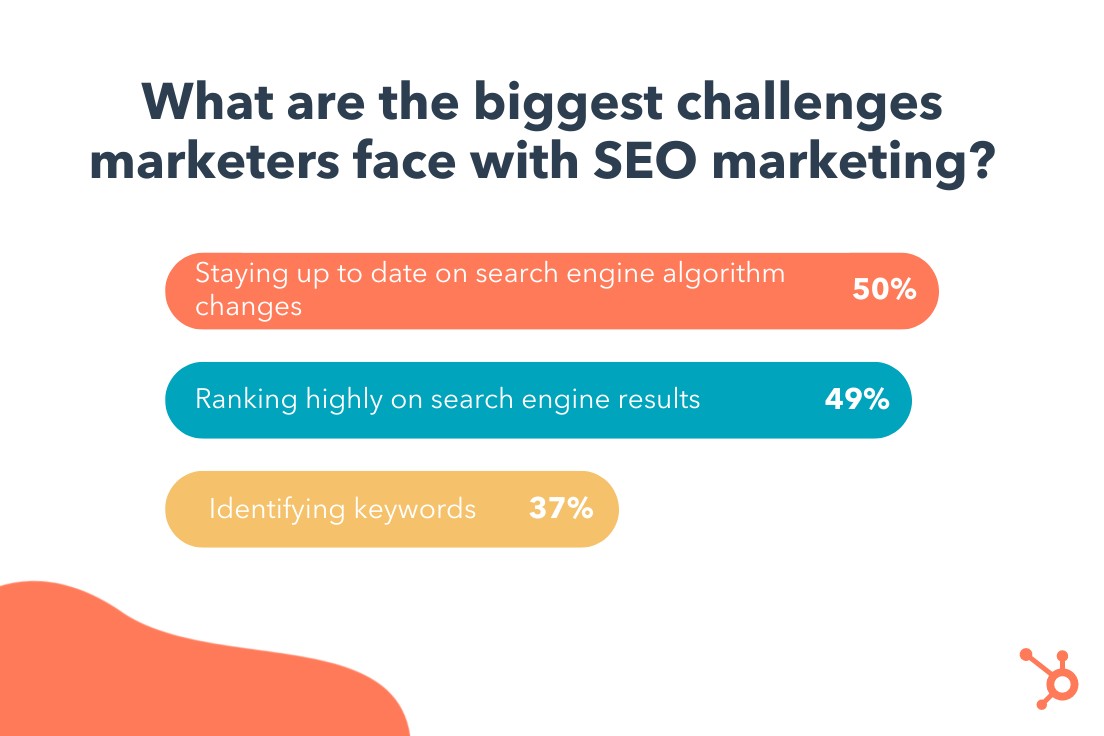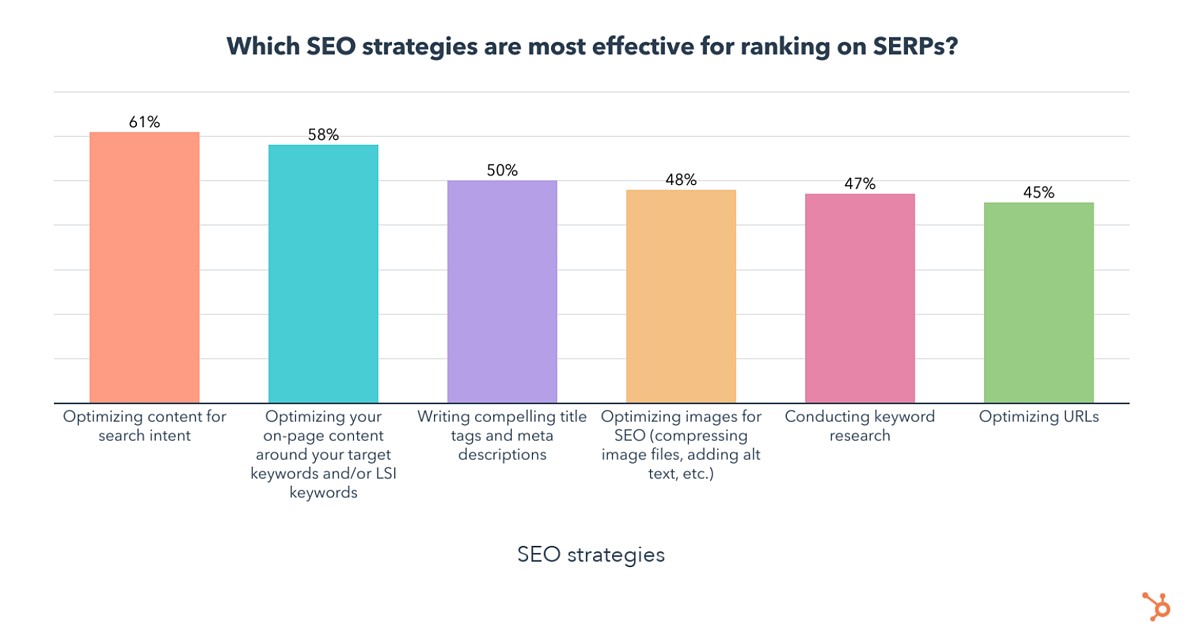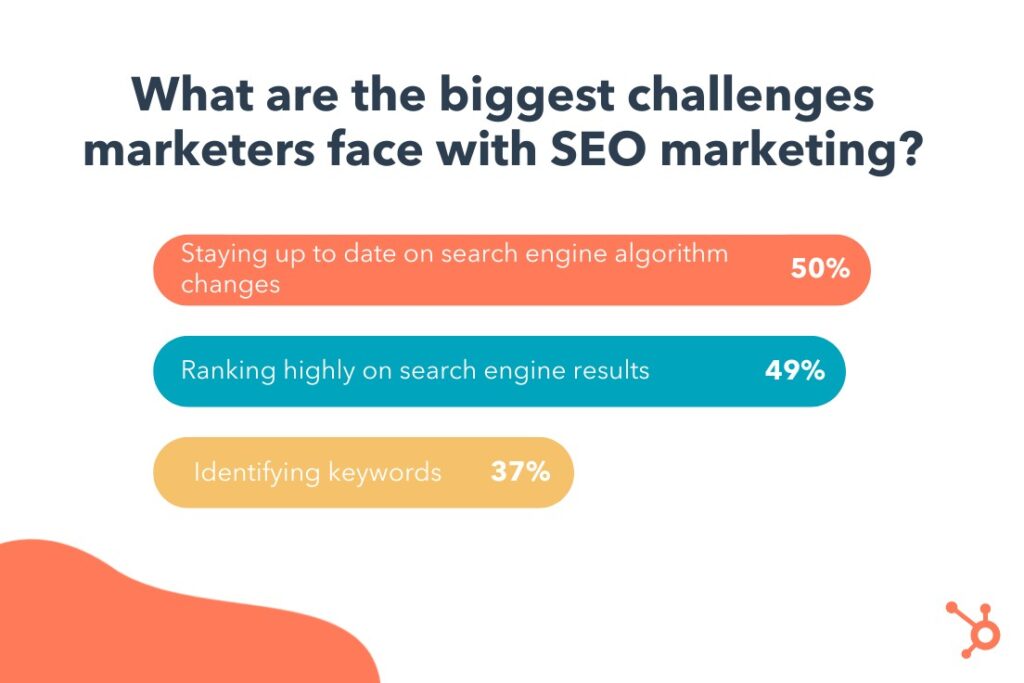In 1990, the key to SEO success relied on keywords. Today, it's way more complicated.
The SEO landscape is constantly evolving, and marketers must evolve along with it. But to do that, it's important reflect on the biggest SEO challenges this year — and create a game plan to address them.
Below, let's review the top six SEO challenges brands are facing in 2022, according to data from HubSpot Blog's 2022 Web Traffic & Analytics Report and other marketing experts.
Top 6 SEO Challenges in 2022
1. Staying on top of algorithm changes.
The HubSpot Blogs surveyed 400+ web traffic analysts to identify the top SEO challenges in 2022. The leading challenge — experienced by 50% of marketers — is staying on top of search engine algorithm changes.

This isn't surprising — in 2020 alone, Google ran more than 500,00 experiments that led to 4,000+ changes to search. For many marketers, staying current with these changes is like hitting a moving target.
So, how can you succeed when Google keeps moving the goal post? The key is to respond to these changes strategically.
There's no need to overhaul your entire SEO strategy in response to a minor change. Instead, your time is better spent staying on top of industry news. If a big algorithm change is on the horizon, the SEO industry will talk about it.
The second tip may sound counterintuitive, but hear me out – after an algorithm change, wait for the dust to settle before making any moves. Why? In some cases, Google reverts to a previous version if an update doesn't go to plan.
2. Not ranking higher in search results.
Unlike paid search, SEO takes time to show results — and it's usually a result of smaller efforts.
There are some "solutions" to fix a low ranking, such as pivoting to technical SEO and content marketing. SEO experts have also identified some factors that play into your ranking, like the E-A-T framework. E-A-T in SEO stands for "expertise," authoritativeness," and "trustworthiness."
However, even more important is developing a long-term strategy that focuses on a handful of initiatives at a time. Remember, SEO is a long-term game. The work you put in today will pay off down the road.
3. Using keywords incorrectly.
One thing has managed to stay consistent in the SEO world: keywords. But today, rather than scanning for keywords, Google takes a high-level look at your website to get an overall sense of its authority, tone, and relevancy.
In other words, if you're hoping that keywords alone will give you a boost in search results, you're out of luck.
Instead, the goal with keywords is to understand user intent, or the deeper problem your users hope to solve. With this understanding, you can inform your content strategy and your larger, overall marketing strategy. Take a look at this helpful article on adding user intent to your keyword strategy.
Additionally, tracking search volume for your targeted keywords can help you understand why your website sees a sudden spike or drop in traffic. For instance, if a target keyword is experiencing a spike in search volume, you can write more blog posts on that particular topic.
4. Writing compelling titles and meta descriptions.
According to 400+ web traffic analysts, one of the most effective strategies for improving search ranking is writing compelling titles and meta descriptions. But writing catchy titles is easier said than done.

According to one recent study that analyzed 5 million headlines, emotional titles — either positive or negative — had a higher click-through rate (CTR) than neutral titles. In fact, both positive and negative titles improved CTR by approximately 7%. Additionally, web pages with meta descriptions get almost 6% more clicks than those without.
But, a word of caution here — while emotionally-charged titles can drive clicks, you run the risk of sounding too clickbait-y. For example, the same study found that "power words" — or words specifically designed to draw attention — can negatively impact CTR. Power words include terms like crazy, insane, and amazing — so use them sparingly, if at all.
5. Missing the mark on mobile.
Your SEO strategy should absolutely include mobile optimization. Why? As you might expect, mobile devices account for a large chunk of web traffic — 41% to be exact — making it essential to approach your website with a mobile-first mindset.
Further, Google now practices mobile-first indexing. This means Google uses the mobile version of your web pages when indexing and ranking pages.

The trend is clear — optimizing for mobile is key for traffic growth, SEO, and great user experience. It's no surprise that almost 25% of companies invest in mobile as a top SEO tactic.
You don't need to be a developer or have a large budget to optimize your website for mobile. Check out this helpful guide to learn how small tweaks can improve the mobile experience.
6. Leveraging video in search results.
If you Google "How to tie a knot," the top search result is a video:

Increasingly, Google is incorporating video in search results — and this trend isn't stopping any time soon. In fact, Google is working on more ways to experiment with short-form videos in search results, according to Google's Product Manager, Danielle Marshak.
Google plans to surface videos by crawling and indexing them like any other type of content. So how can marketers leverage their video content for search? Here are a few strategies:
- Add video chapters. Chapters section your video by topic, providing a layer of context for viewers. It also makes it easy for Google to understand the content in your video and use different clips in search results.

- Optimize your title, tags, and description. Like web pages, videos also have titles, descriptions, and tags. Optimize these using SEO best practices.
Also, embedding videos into your website and blog posts doesn't hurt — and can actually improve your bounce rates.
Back to You
SEO is like a mutual fund — it builds over time, one dollar at a time. In other words, it's a long game. Marketers must have the right strategies in play for the long game. Start with the tips in this post to set you on the right path.


